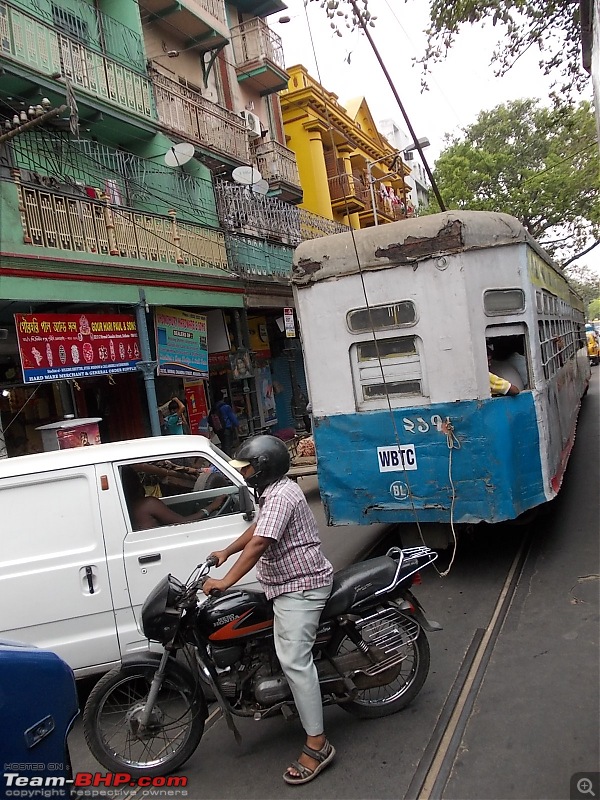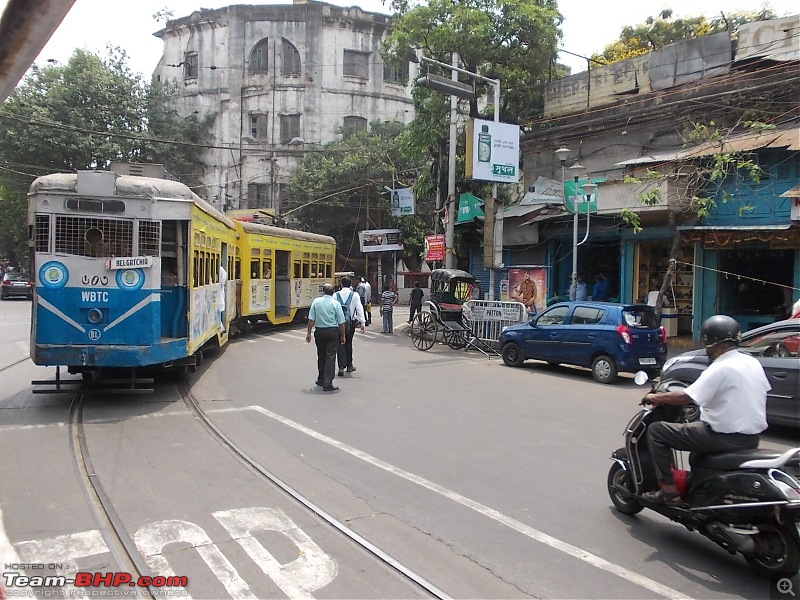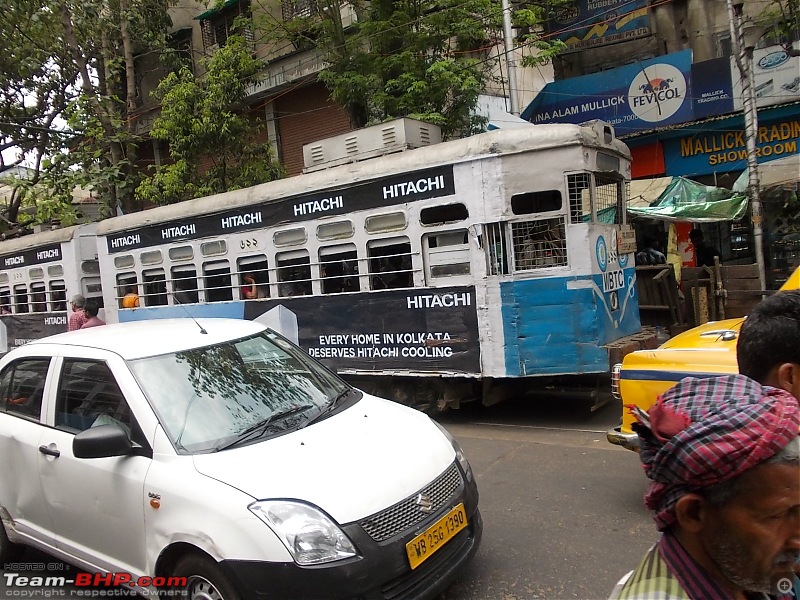Team-BHP
(
https://www.team-bhp.com/forum/)
Quote:
Originally Posted by rahul4640
(Post 3180521)
Saw this picture today on Facebook. Picture credit goes to Mr. Johnny Purty. Is this an air-conditioned tram? Why is the door beside the driver closed?
|
Don't think it's airconditioned. Going by the puddles and umbrellas in the photo, it's probably all closed up because of the rain.
In India, anything with an AC is luxury, so they'll never allow trams, local trains and regular buses to be airconditioned.:OT
An old picture (1873) of a horse driven tram in Calcutta:

(from FB page Old India Images)
Quote:
Originally Posted by anjan_c2007
(Post 3279400)
An old picture (1873) of a horse driven tram in Calcutta: Attachment 1159899
(from FB page Old India Images)
|
It is indeed interesting to note that the horse-driven tram has two decks and also has a suspension.clap:
Lovely engineering! :thumbs up
Cheers!
Fintail/Heckflosse!
Two old tram painting and picture respectively clicked from framed photos in the hotel where I had halted in Kolkata:

An artist's impression

An old picture
Quote:
Originally Posted by anjan_c2007
(Post 3112954)
Trams were earlier very common in Kolkata and Bombay as far as memories of the present generations go. The first electric tram service was started in Madras in 1895. Electric trams were subsequently introduced in Kolkata (1900), Mumbai (1907), Kanpur (1907) and Delhi (1908).
|
Quote:
Originally Posted by faustus77
(Post 3112959)
You forgot to mention Delhi.
They too had trams in the 1950 and early 1960s.
|
Two other cities with Trams were Nasik (1889 to 1933) and Patna the short lived trams in Patna were Horse drawn and remained so till their early end due to low patronage, while those in Nashik were initially Horse drawn and later converted to petrol driven ones. In Nasik they ran only one route from the old municipal council building to the station which was about 9 km away from the city.
Galiff Street Tram Depot, Calcutta.

Wow!
This thread may be nostalgia for few but for someone like me who's never been to Kolkata or on a tram, this is an interesting and informative read. Thanks to all for sharing the lovely pictures. A few years down the line after all the trams are gone, this is the only way one can know that Trams did exist.
I had seen trams in Warsaw, Poland when I had been there. They were red and yellow in color and were slightly faster than those in Kolkata. There were also buses, powered by overhead electric cables. I thought, hope someday it comes to India so there would be lesser pollution. But today I came to know that this was in India years ago but phased out.
Thanks again to everyone.
This brought back my Kolkata memories! The most intriguing thing about trams was the way they still move traffic, by sounding bells right in the middle of a street. It was something new to see tram stop due to traffic and move as the signal and vehicles clear.
The highest fare I've paid was probably 3.5 Rs. More over, it was interesting to see that the conductor promptly pays back 50 paise to all the passengers! I hope this legacy stays in India for years to come.
I wish I could see the trams on the Howrah Bridge. Oops, it is the old Howrah bridge now!
:)
Well well, if anyone was thinking of trams as a dying breed, think again. Allow me to introduce to you the latest trams in the world:
Some clicks from Kolkata from 14/05/2015


An update:
The Ballygunge Tram Depot is back in action since more than one year now. It was closed down for a few decades till around mid 2015.
As a result now, like before, trams from Ballygunge move to Gariahat and further to Tollygunge or towards Park Circus and beyond.
Thats an encouraging sign, owing to the earlier understanding that the trams were barriers to the smooth flow of traffic and were to be curtailed routewise.

(image above clicked on the Ballygunge- Gariahat Square route)
Some more recent images


Some non-bhpian trivia if I may:
1) In the sixties, several trams were burnt as a protest against a 1 paisa fare hike.
2) In the mid fifties, a contemporary, famous Bengali poet, Jibanananda Das, died after a tram accident. Actually considered quite bizarre, getting hit by a tram. A few critics, (and this was a rumor, mind you), reportedly attributed the mishap to one of his "poetic" trances, wherein he had gone to check out how the tram track smells, to pen down his next abstract poetry!
It's very much a part of Bengali middle class nostalgia, and romanticism. First class and Second class coaches, and that sound of the bell ringing.
Again, during my last visit to Kolkata last week, I travelled by tram though for a short distance from Gariahat Crossing to Rashbehari Square in South Kolkata. The distance is about 3 kms and the charges were Rs 6=00 (the minimum fare). Thats unimaginable and this fare has been constant since the past about five years or so, if what I was told is true. The tram could be at least 45 plus years old going by its looks, but it took its load of a few passengers with the same agility as a new one.
The fares till the late 1970's would be 15=00 paise for the rear compartment (II Class with no fans) and 20=00 paise for the front compartment (First Class - it had ceiling fans). The fares are uniform for both the front and rear compartments as both have fans these days.
The driver is seen in the first pictures, so also painted are the omnipresent instructions "beware of pickpockets, "no smoking", "care for the tram as it is yours" and the like. In one picture, the wooden floor is seen. One instruction in Bengali says that "Advertisements are not welcome", rather bluntly meaning "stick no bills". The outer surface of the tram is painted with a Hitachi advertisement, the inside contrarily says "No advertisements !" The inside instruction would have hence actually meant "stick no bills" to shoo away advertisers who usually stick A 4 size printed sheets, advertising their products or services like "Plots/ Flats for sale", " Coaching Classes", " Work from home", "Massage therapy" and so on for free and dissappear.:uncontrol.












| All times are GMT +5.5. The time now is 19:46. | |




























